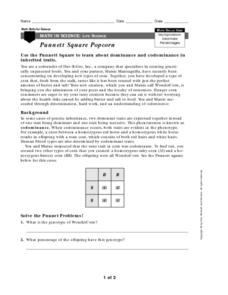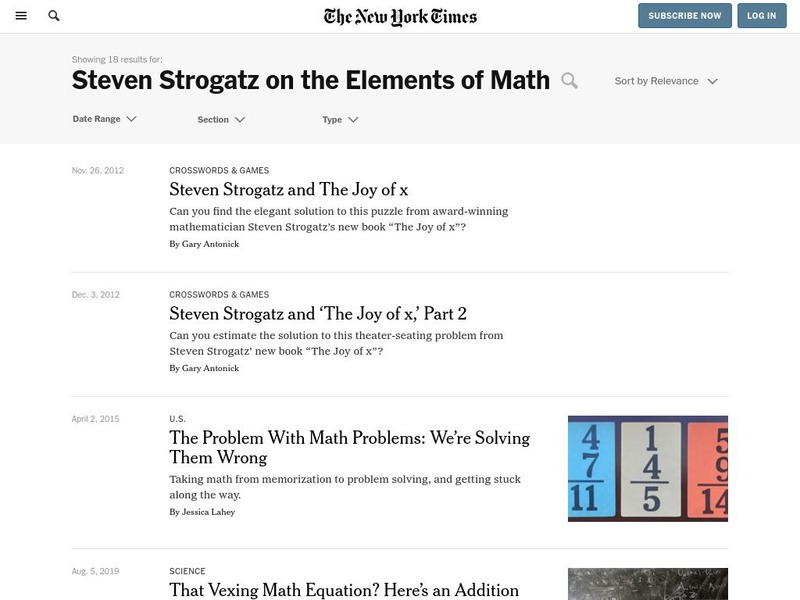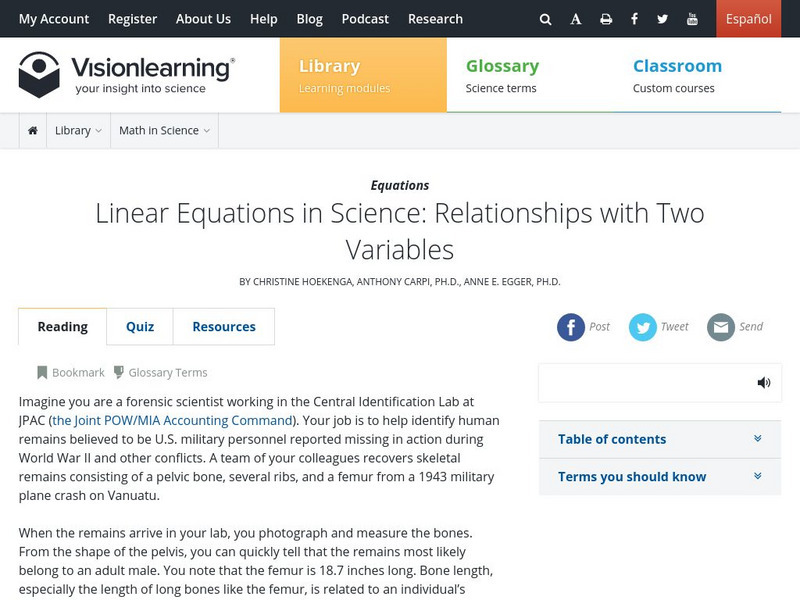Curated OER
Math in Science-Knowing the Calories You Take In!
I can burn off one scrambled egg in 30 minutes of walking? Explain how we daily consume and burn calories using this fun worksheet, which breaks down basic foods and activities into kilocalorie equivalents. Nutritionists calculate the...
Curated OER
Math in Science-Rain Forest Math
In this rain forest worksheet, students use different basic math skills to calculate the percentage of Earth covered by rain forests today compared to fifty years ago. They study the effects of how cutting down trees contributes to water...
Curated OER
Math in Science-Sound Reasoning
For this basic math skills worksheet, students use division, decimals and multiplication to calculate the speed of sound in water and compare it to the speed in air. They calculate distances sound travels in water and the time it takes...
Curated OER
Math in Science-Radioactive Decay and Half-Life
In this radioactive decay and half-life worksheet, students use given half-lifes to calculate the amount of time it will take for certain amounts of elements to decay. They also find the age of samples and determine how many grams of...
Curated OER
Math in Science-Using Temperature Scales
In this temperature scales worksheet, students are given the equations to convert from Fahrenheit to Celsius and from Celsius to Fahrenheit. They apply to equations and convert given temperatures.
Curated OER
Math in Science-The Pressure is On
For this pressure worksheet, students find the pressure of objects using the equation for pressure. They find the pressure of air in the atmosphere and the pressure of water in the ocean at different depths.
Curated OER
Rain On
Fourth graders study the water cycle and clouds. In this water cycle and cloud lesson plan, 4th graders determine the definition of condensation and watch a demonstration in which the teacher makes a cloud in a bottle. They discuss the...
Curated OER
Galaxies and the Universe
If Earth was formed 4600 million years ago, and the sun revolves about the center of the Milky Way once every 250 million years, how many revolutions have occurred? Learners answer this question and ten more, all providing students with...
Curated OER
Color at Light Speed
Rainbow science anyone? learners put the color specturm, frequency, light waves, and wavelengths into a light speed context. They use algebraic formulas to determine the speed of each light wave length. A great way to connect math and...
Curated OER
Sedimentation in the Grand Canyon
In this sedimentation worksheet, students use the current rate of sediment deposit by the Colorado River in the Grand Canyon to answer questions about the changes taking place in the canyon. They graph the amount of deposit over 75 years...
Curated OER
Average Speed in a Pinewood Derby
In this average speed worksheet, students are given the distance a derby car must travel and its time for three trials. Students find the average speed and answer four questions about the data.
Curated OER
Geological Time Scale
In this geological time instructional activity, student use a geologic time scale to understand the difference between eons, eras, and periods. Then students complete 2 short answer questions.
Houghton Mifflin Harcourt
Random Samples: Estimating Population
With this estimating populations assignment, your class will learn about taking random population samples and calculating the average number of species in the samples to estimate the total population. Students use the given data to find...
Curated OER
Scale of Organisms
In this scale worksheet, students use the SI system to compare the sizes of some of the smallest and largest organisms on Earth. This worksheet has 7 problems to solve.
Curated OER
Punnett Square Popcorn
In this genetics activity, students use the Punnett Square to learn about dominance and codominance in inherited traits. This activity has 1 short answer question and 6 problems to solve.
Exploratorium
Exploratorium: Microscope Imaging Station: Classroom Explorations
These microscope activities provide students with lots to explore. Activities include the characteristics of living things, math in science, cell biology, genetics, physiology, and mitosis.
New York Times
New York Times: Steven Strogatz on the Elements of Math Series the New York Times
[Free Registration/Login Required] On this site, Cornell University mathematics professor, Steven Strogatz, shares his 15-part series of columns on the elements of math. He investigates topics ranging from negative numbers to subtraction...
Other
American Mathematical Society: Mathematical Moments
Use this resource to promote an awareness of mathematics as it occurs in nature, science, technology and human culture. This series of articles and podcasts can be used as teaching resources.
Vision Learning
Visionlearning: General Science: Unit Conversion: Dimensional Analysis
Instructional module focusing on the importance of unit conversion in science. Discussion includes unit consistency and dimensional analysis. Site also includes an interactive practice quiz and links relating to the topic.
Vision Learning
Visionlearning: Exponential Equations in Science: Growth and Decay
Definition of exponential equations and an explanation of how they relate to science.
Vision Learning
Visionlearning: Linear Equations in Science: Relationships With Two Variables
An introduction to the history of linear equations and how they relate to science.
Vision Learning
Visionlearning: Exponential Equations in Science: Constant E, Limits to Growth
An introduction to exponential equations that describe growth and decay over time. Variables and constants in the equation are explained.
Vision Learning
Visionlearning: Wave Mathematics: Trigonometric Functions
Learn how to use trigonometric functions to study waves.
Vision Learning
Visionlearning: Statistics: Introduction to Inferential Statistics
An introduction to inferential statistics to find relationships and patterns in datasets.

























